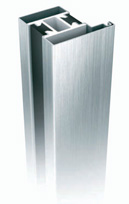Clean, precise, impervious, stainless steel with its structural qualities is the perfect choice to define large spaces. With either a satin or polished finish, it conveys a modern and highly technological interpretation of today’s way of life.
The corrosion resistance and structural stability of stainless steel give an everlasting appearance. It’s an excellent choice for coastal applications and highly corrosive environments.
Stainless steel is an iron alloy containing chromium, nickel, and molybdenum. It was discovered in 1913 by Englishman Harry Brearly after realizing he created a metal which resisted rusting when exposed to atmospheric elements. By varying the quantity of the alloys, over 100 different types of stainless can be manufactured, each containing different structural properties and resistance to corrosions. In addition to its physical benefit, different manufacturing methods can be used to create either a high luster or matte finish, which create a variety of design options.
The billet used for stainless steel is produced by forging the steel to the required gauge, then rolling it into large coils. The material then undergoes a finishing process to obtain a satin, scotch-brite, or polished surface. The coil is then rolled into the desired shape while a protective film is applied to protect the finish.


1. Satin
220 grit abrasives are rubbed
over the surface to obtain a
smooth satin polish

2. Scotch-Brite
1,200 grit abrasives are rubbed
over the surface to obtain a
sleek smooth finish

3. Polished
High powered buffers are used
to create a mirror like finish
